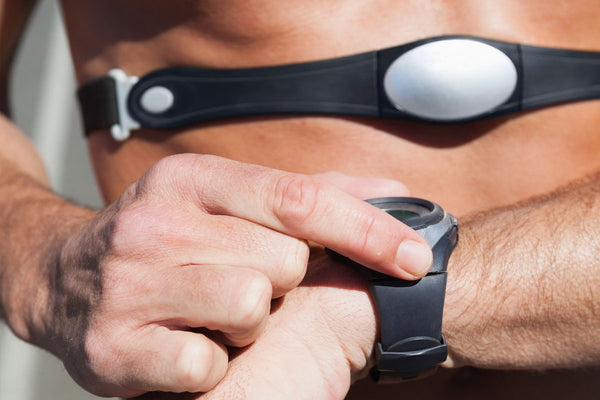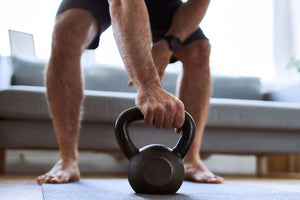If you’re looking to lose weight, then you’ve likely heard that it’s best to exercise in your “fat burning zone.”
Despite your best efforts, the sheer amount of information/misunderstanding about what the fat burning zone is overwhelming. While the notion of a “fat burning heart rate” sounds enticing, we’re here to help you separate fact from fiction concerning fat burning workouts and what it actually takes to lose weight fast.
Let’s start with the basics.
What is a Fat-Burning Heart Rate?
Heart rate is used as one of the primary ways individuals gain the intensity (often mistaken for “effectiveness) of his/her workout.
An elevated heart rate during exercise means that you are stressing the body to a certain extent, which means your body needs to produce more energy (ATP) to sustain this higher level of effort.
To create ATP, your body has a few options.
First there’s the very limited amount of ATP that’s in every cell of your body. This is usually enough to sustain increased effort for a few seconds. After existing stores of ATP are used up, the body then turns to creatine-phosphate (the stored form of creatine in muscle cells), which can be used to increase the body’s native ATP stores.
As these stores get depleted, the body then turns to carbohydrates (glycogen or blood sugar) as well as fatty acids to continue to generate ATP.
When you’re exercising in your “fat burning zone” (fat burning heart rate), the body is primarily using fatty acids that have been liberated from fat cells (adipocytes) to generate ATP.
Is a Fat Burning Heart Rate Necessary to Lose Weight?
As the name implies, exercising in your “fat burning zone” should make you lose body fat faster, right?
Not necessarily.
There are a few things to keep in mind.
First, when training in your fat burning zone, your body is primarily burning fat for fuel, but there’s also a certain percentage of carbohydrates/glucose that are being used to generate ATP. As the intensity/duration of exercise increases, the ratio of sugar-burning to fat-burning shifts more and more in favor of carb/glucose-burning.
Second, even though you're training with a fat-burning heart rate during your gym workouts, that doesn’t necessarily mean that you will lose body fat. Remember, in order to lose body weight, you must be in a calorie deficit. So, even if all of your cardio and resistance-training workouts technically have you in the “fat burning zone”, you will not lose weight if you’re eating too much food.
Third, your body still burns calories, even when you’re not exercising, and fat is the body’s primary form of “stored energy” when food is in scarce supply (aka dieting).
In other words, just because you perform a “fat burning workout” or your smartwatch/fitness tracker says you’re in the fat burning zone, doesn’t translate to automatic weight loss. Focus first and foremost on eating the right number of calories to support your goals -- fat loss, muscle gain, etc.
Does this mean that training in your “fat burning zone” is useless?
Not at all. Many of today’s top coaches have their athletes “train low” to “compete high.”
What this means is that even top-tier athletes spend time training at a lower intensity (i.e. a lower heart rate zone) even when their sport is higher intensity, such as endurance athletes, sprinters, field sport athletes, etc.
The reasons for this are many, including (but not limited to) training the body’s other energy systems (carb vs fat burning) and the fact that research shows that training at reduced intensities improves markers of high-output performance, such as VO2 max.
Furthermore, training in the fat-burning heart rate zone is less stressful on the body than high-intensity interval training (HIIT), which means that it may be easier to recover from, thereby allowing you to train more frequently, burn more calories, and get the result you want!
How to Calculate Fat-Burning Heart Rate
For a long time, researchers held to the notion to a “fat-burning heart rate” occurred at around 70% of your maximum heart rate. An individual’s max heart rate was defined as 220 - your age).
However, as exercise science has evolved, researchers have come to understand that an individual’s maximum heart rate is affected by multiple factors, not just their age. Base fitness level, lifestyle stress, sleep quality, diet, genetics and many other factors affect an individual’s maximum heart rate.
Currently, researchers measure “maximum heart rate” using a graded exercise test, but seeing as most people don’t have access to a group of researchers in a controlled lab setting to put them through said exercise test, the “220 - current age” can serve as a rough estimate.
So, if you want to estimate your target fat-burning heart rate, subtract your current age from 220. Then, multiply that result by 0.7 (70%).
If you have a fitness tracker, then it will usually alert you when you enter your fat-burning zone during a given workout.
The Best Way to Lose Fat
Again, just because your workout has you exercising in a fat-burning heart rate zone doesn’t mean that you will automatically lose body fat. It just means that in that given moment, your body is getting more of its ATP from the breakdown (“burning”) of fatty acids than it is carbohydrates/glucose.
To consistently and effectively lose weight, you need to focus on:
- Maintaining a caloric deficit
- Eating enough protein each day
- Getting 7-9 hours of quality sleep
- Managing lifestyle stress
If you need help figuring out how many calories you need to lose weight and/or tracking your macros to know whether you’re eating too much or too little, download the 1UP Fitness App where we provide FREE, customized calories/macro targets to support your transformation challenge.
Last, but not least, don’t forget about supplements. While they can’t replace proper diet and hard training, the right supplements, such as Pro Ripped Max and Make Her Lean Max, can support your efforts, helping you to stay on track with your program and get results quicker!






